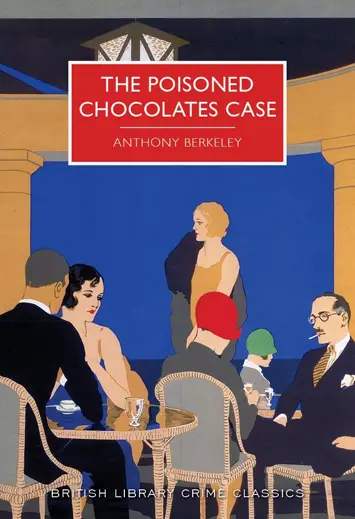The Poisoned Chocolates Case by Anthony Berkeley – Review

By Sandra Callard
I’ve already confessed my love for these reprints by the British Library of old crime novels from the early twenties and thirties. They are so indicative of their era that they immediately transfer you to a world so different from our own, but which is still so very relevant today.
Anthony Berkeley, a very successful author of crime books, published The Poisoned Chocolates Case in 1929. The previous year Berkeley had come up with the idea of forming the Detection Club, a selection of crime writers who were presented with a crime, sometimes an actual one, which they each had to solve and then explain how they had come to their conclusion. The club was very successfully adopted in 1930 and is still in existence.
The story we have here is typical of its genre. A wealthy man is sent a box of chocolates by post to his club, apparently by the makers of the chocolates, asking for his thoughts on some new flavours they were introducing. The man is annoyed by this as he hates chocolate and so gives them to another member of the club, who passes them on to his wife. His wife persuades him to try one, which he does, but she eats far more. The result is that Mrs Bendix dies a painful death and her husband is very ill but he recovers.
A Chief Inspector friend of the Detection Club’s leader passes the confusing case to the members of the Club in the hope that one of them may give the police some clues. The result is fascinating and occasionally funny, as the Inspector now has six different solutions to the murder, each one incredibly astute, possible and very pertinent. The reader also has the six possible solutions to play with, or is it in fact none of these and something completely different?
“Beautifully described”
 This is no comfortable read with your feet up and a necessary drink to hand. Your brain spins until, in my personal experience, I gladly give up and waited for the real solution to be exposed. But the journey is superb, and even though you know you will never tie the clues together in the correct way, it is such a joy to have a go. The book is not too long, though not by any means meagre, as the author seems to know how long the reader can take the business of whodunit to its maximum. But the denoument is everything it should be, as are the twists that are unexpectedly thrown at the reader.
This is no comfortable read with your feet up and a necessary drink to hand. Your brain spins until, in my personal experience, I gladly give up and waited for the real solution to be exposed. But the journey is superb, and even though you know you will never tie the clues together in the correct way, it is such a joy to have a go. The book is not too long, though not by any means meagre, as the author seems to know how long the reader can take the business of whodunit to its maximum. But the denoument is everything it should be, as are the twists that are unexpectedly thrown at the reader.
Berkeley’s writing is superbly clear, and the story not only sets out the clues of the story in an understanding way, it also throws a fascinating light on those times just after World War One, when nobody knew how close they were to World War Two. But although the setting of the story takes place mainly in the house of the leader of the Club, the outside settings are beautifully described as the lives of the ordinary people pass by and add texture to the story.
The book is one of many of its ilk that were written during the twenties and thirties, that were incredibly popular. Indeed, the Queen of Crime herself, Agatha Christie, is known to have been an avid reader of Anthony Berkeley. To me personally this an absolutely lovely and interesting read which I can easily imagine has been read by my parents and grandparents, and enjoyed just as much. I will keep a look out for further reproductions of Berkeley’s novels and hope for another fascinating and clever read.
‘The Poisoned Chocolates Case by Anthony Berkeley’ is published by the British Library, £8.99 paperback









